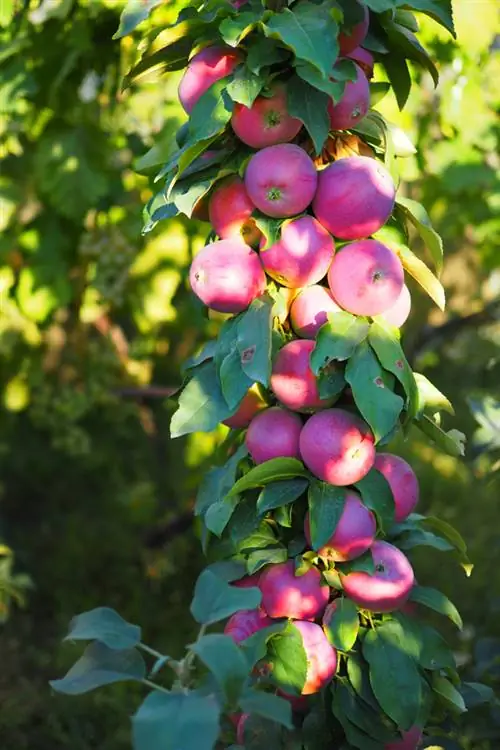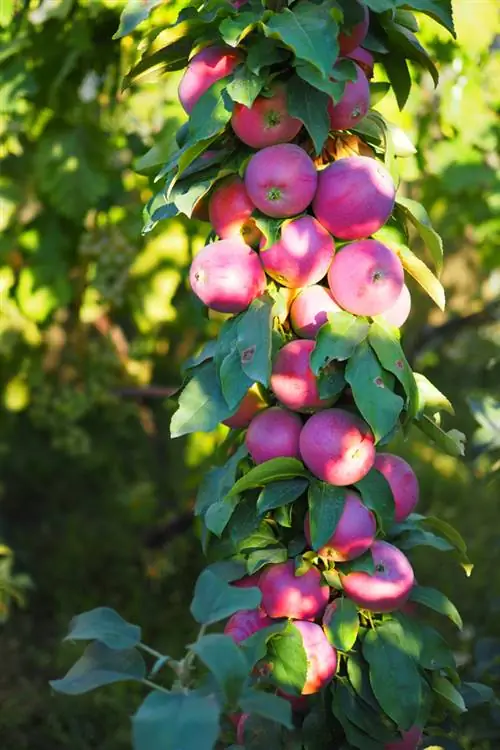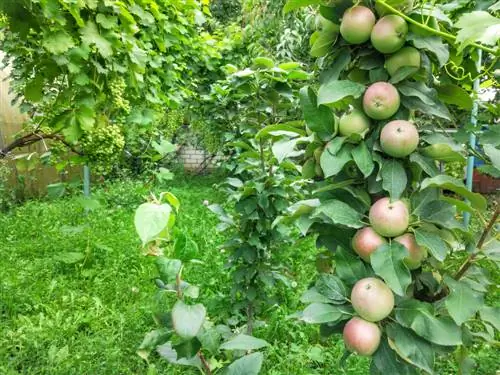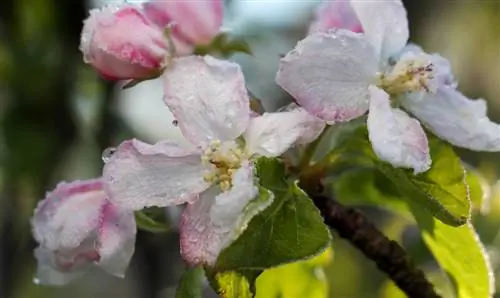- Author admin [email protected].
- Public 2023-12-16 16:46.
- Last modified 2025-06-01 06:02.
Today's columnar apple varieties were created from careful selection of apple trees that naturally grow very slim and remain small. A few years ago there were only a few varieties, but today the selection is very large: from the red-cheeked, sweet apple to the sour apple, similar to the Red Boskoop, you will find the right apple for every taste. However, remember to always plant several trees together: columnar apples are generally not self-pollinating.

Which columnar apple varieties are there?
Popular columnar apple varieties include Red River, Redcats, Goldcats, Starcats, Berbat, Black McIntosh, Goldbäckchen, Rhapsody, Jarle, Sonata, Rondo and Jucunda. These differ in height, color, harvest time, aroma, storage life and special features such as robustness and disease resistance.
Be careful when buying: Not every pillar apple is actually one
But before you happily grab the first columnar apple offering at your local garden center, take a close look at the plant label first. Not everything that is called a “pillar apple” actually is one. Quite the opposite: In many cases, the supposedly columnar-growing variety is a completely normal apple tree that is only kept slim through targeted pruning measures. If you stop cutting, it will develop normally and form a crown. However, you can recognize real columnar apples by these features:
- grows tightly upright
- forms no or only hardly any side shoots
- only minor cutting measures necessary
- Flowers and fruits sit directly on the trunk
- reaches a maximum height of around 400 centimeters
The best varieties
The first generation of columnar apples is also known as “Ballerina”, they have quite dancey variety names such as ‘Polka’, ‘Flamenco’ or ‘Bolero’. Today, however, these varieties are no longer a competitor to the new breeds in terms of taste, disease resistance and yield.
| Variety | Growth height | color | Harvest time | Aroma | Storability | Special features |
|---|---|---|---|---|---|---|
| Red River | 300 - 400 cm | red | September - October | subtly sour | yes | Self-fertile, high-yielding, mushroom-proof |
| Redcats | 300 - 400 cm | red | Mid to late September | sweetsour | low | robust, resistant to many diseases |
| Goldcats | 300 - 400 cm | yellow | from mid-September | sweetsour | yes | robust, resistant to many diseases |
| Starcats | 300 - 400 cm | bright red | September to December | crunchy sweet and sour | yes | robust, resistant to many diseases |
| Berbat | 200 - 300 cm | red | Mid-September to mid-November | mostly sweet | low | robust, rich-bearing |
| Black McIntosh | 300 - 400 cm | dark red | Mid-September to end of November | juicy, mild | low | strikingly dark fruit color |
| Goldencheeks | up to 300 cm | red-yellow | October | crunchy, juicy, balanced | conditionally | very slim growth |
| Rhapsody | 300 - 400 cm | red-green | October-December | finely sour, juicy | yes | very robust |
| Jarle | 300 - 400 cm | red | September - November | crunchy-sweet | yes | fruits in the first year |
| Sonata | 300 - 400 cm | red-yellow | September-November | juicy, sweet | conditionally | excellent taste |
| Rondo | 300 - 400 cm | green-yellow | September-November | sour-sweet, juicy | conditionally | resistant to many diseases |
| Jucunda | 300 - 400 cm | redflamed | from the beginning of October | juicy, sour.-sweet | yes | scab-resistant |
Tip
Like all apple trees, columnar apples prefer a sunny location. If the tree is too dark, it will only produce a few flowers or even no flowers at all.






